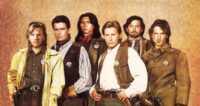How I Learned to Fly, the debut feature film from Swiss writer-director Simon Steuri, in theaters this week, is in many ways similar to other coming-of-age films from across the world: its adolescent protagonists are confronted with a series of traumas they must, with the help of others, transcend—or to which they might, sadly, succumb. Those traumas might come in the form of abuse, trafficking, gang violence, drugs, or, in the case of How I Learned to Fly, the absence of parents and the threat of homelessness. The Swiss writer-director’s narrative is a fiction, but it’s one based in part on his own childhood, and its tale of two Black teenage brothers struggling to survive is nothing if not earnest.

Elder brother Daniel (Marcus Scribner of ABC’s hit sitcom Black-ish) is confronted with a new set of responsibilities when he finds his mother dead and his abusive father missing. It’s left to Daniel to manage the household and pay the rent, but his work as a dishwasher won’t put much food on the table, and it’s not enough to cover expenses: he’s reduced to scrounging scraps from the restaurant where he works to feed himself and his little brother. Eli (Lonnie Chavis of NBC’s This Is Us) seems deeply scarred by his mother’s absence and can barely cope with everyday life. He quits talking to Daniel and at school (a form of selective mutism, it seems), speaking only in halting messages to his deceased mom’s voicemail. Elsewhere, his only communication is by text message or scrawled note, and his rash decisions make Daniel’s already-difficult job even more so.
Worse, Daniel’s college applications are unsuccessful, leaving him with little hope for the future, and soon the two are homeless, living in their parents’ abandoned car. Theirs is practically a textbook case of youth facing what mental health professionals call Adverse Childhood Experiences: a lack of food, housing, safety, security, friends, parents—and a near-constant threat of violence, addiction, and/or abuse. That Eli will not talk and that Daniel has no one other than Eli to talk to not only exacerbates their situation: it also makes matters such as simple exposition difficult.

Chavis and Scribner do their best with the material to portray a pair of brothers whose situation seems hopeless but whose love for each other runs deep. In flashbacks, Cliff Smith—Wu-Tang Clan’s Method Man—plays the pair’s abusive father—Cedric the Entertainer a concerned neighbor, and Michele Selene Ang a young woman the two befriend, though none of these supporting roles matters greatly to the narrative (and Ang’s exists for little purpose except to motivate Eli’s speech). How I Learned to Fly rests almost entirely on the shoulders of the two actors who play the brothers, and Davis and Scribner’s performances are nearly enough to make the film’s tale of resilience in the face of trauma resonate.
That a tale of Black trauma on the streets of L.A. be told and directed by a white filmmaker from Switzerland is something of a surprise. Steuri reports he was, in his childhood, much like younger brother Eli: not mute from trauma, necessarily, but socially withdrawn; highly gifted but largely unable to communicate with others; inspired by art but afraid of people. In taking inspiration from his own challenges as a youth in Switzerland to make them more universal, Steuri has sought to make his tale one to represent a broader swath of those whose childhood adversities have left them without homes or families. Even so, some are likely to look a little askance at a tale of Black trauma directed by a white European, especially at a time when Black filmmakers are still wanting for opportunities.
As a director, Steuri’s instincts lean toward the artistic. Nearly every scene—and nearly every simple action—is conveyed with jump cuts, every scene with flashbacks, every transition with images intended to signify as visually arresting. When dialogue concludes, an incessant piano intervenes as if it had been held hostage and a plaintive voice warbles away to convey to viewers they are supposed to register a deep emotion. There are moments that seem directly influenced by Barry Jenkins’ now-seminal Moonlight (2016)—the camera frequently following from behind, a moonlit talk on the beach, even a static AM radio hit and a vintage car—but with little of that film’s novel confidence.
It’s hard not to wish here for scenes cut with less editorial intervention, less flashing forward and back, and less intrusive non-diegetic music. (Steuri is also credited as the film’s editor). A film like How I Leaned to Fly stands in stark contrast to the narrative simplicity of the Dardenne brothers, who can tell a tale like this one with a frank directness that is both compelling and enthralling. While there are plenty of circumstances where a film is best served by a single guiding vision, here it seems a director might have made different decisions working with a different writer’s story and an editor might have cut the film differently had he not written and directed it himself. It feels like the constant music, cuts, and narrative jumps are masking a lack of confidence in the narrative and the actors hired to convey it.
How I Learned to Fly may well connect with audiences looking for an earnest depiction of two teens’ journey of survival. Eli and Daniel together share an enduring brother love that transcends their trauma, and at more than one moment the film reaches a pleasant poignancy. There may well be dozens if not scores of stronger, more meaningful and more resonant coming of age stories being released every year across the globe, but here in the United States there is still a dearth of films representing Black youth, and How I Learned to Fly aims to convey the emotion and challenge of two young brothers whose lives are challenged by their situation.
How I Learned to Fly opens in select theaters December 1, 2023.




